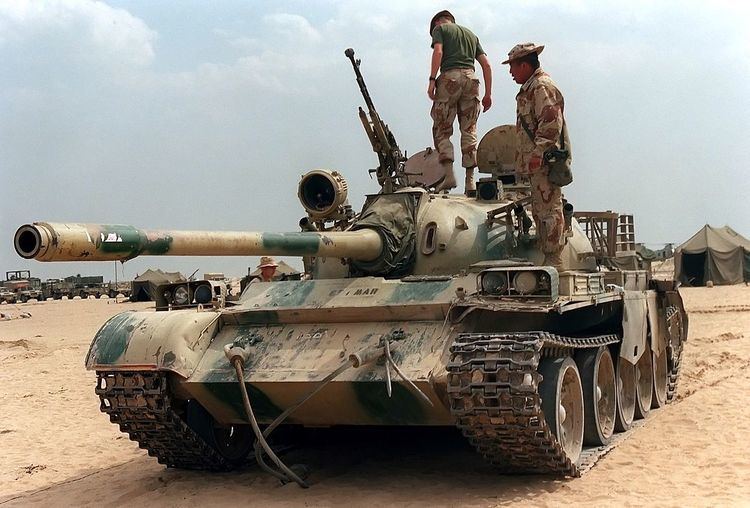Type Main battle tank In service 1982 – present | Place of origin China Designed 1963 – 1974 | |
 | ||
Wars Iran–Iraq War, Gulf War, Iraq War Designer No. 60 Research Institute | ||
The Type 69 (Chinese: 69式; pinyin: Liùjiǔ shì) and Type 79 (Chinese: 79式; pinyin: Qījiǔ shì) are Chinese medium tanks. Both were developments of the Type 59 (based on the Soviet T-54A). They were the first main battle tanks developed independently by China. Their lineage can be seen through the distinct gap between the first and second road wheels. Other improvements included a new engine, ballistic computers, and laser rangefinders. The more advanced Type 79 variant was equipped with a 105 mm rifled gun which was also found on the Type 80 tank.
Contents
History
After the Sino-Soviet split, the Soviet Union withdrew its technical staff and support to China's arms industry. This caused China's domestic tank development to stagnate significantly. In 1963, the PLA ordered the development of a new tank based on the Type 59 and which was to be named the "Type 69". In 1965, development objectives were finalized and the product was named "WZ121" internally. In 1966, the first prototype rolled off the factory. However, the Cultural Revolution and its resulting chaos further curtailed tank development.
During the 1969 Sino-Soviet border conflict, the PLA was able to capture a Soviet T-62 MBT. The captured tank was examined, and some of its components, such as the Soviet Luna IR searchlight system, were copied and integrated into the Type 69 design. After around a decade of development, the first domestically developed and produced Chinese tank was inducted into the PLA ground forces as the Type 1969 Medium Tank or Type 69 Tank for short. However, the early version of the Type 69 were only used in limited quantities.
Relations between China and the West warmed in the 1980s, and China was able to import some Western technologies to improve its weapon systems. The Type 69 was upgraded with Western systems such as the British Marconi FCS, and the L7 105 mm gun. The new version received the designation Type 79, which represented the conclusion of China's first-generation tank development.
The PLA was unsatisfied with the Type 69's performance, but ironically it became one of China's most successful armored vehicle exports. Over 2,000 were sold worldwide in the 1980s. The simplicity, robustness and low cost of the tanks made them attractive on the export market, and China sold hundreds to both sides during the Iran–Iraq War. (Gelbart 1996:18) Many of the vehicles were later used by Saddam Hussein during the Gulf War and the 2003 Iraq War.
Myanmar Army Type 69 tanks also reportedly engaged Royal Thai Army M60A3 tanks in 2001 during the battle for Border Post 9631, although it is unclear if either side lost any vehicles.
Both the Type 69 and Type 79 tanks share almost identical hulls and turrets with the older Type 59. The only difference is that the two more recent tank models have been upgraded with better technologies that were either captured or bought from more advanced countries. (Gelbart 1996:17-19) The Chinese Type 59, 69 and 79 tanks can therefore be viewed as part of the same, evolutionary tank family in the same way that the Soviet T-54, -55 and -62 tanks share a common lineage.
Today only a couple hundred Type 69/Type 79s remain in PLA inventory, mostly deployed with training or reserve units. The Type 69/Type 79 are being replaced by the newer Type 96 and Type 99 MBTs.
In Iraqi service
During the 1980s, China was reported to have sold hundreds of Type 59 and Type 69 MBTs to Iraq. By 1991 Gulf War, western analysts claim that Iraq had upgraded some Type 69s with a 105 mm gun, a 60 mm mortar, and a 125 mm gun with an auto-loader. All of them were reinforced with frontal layer armor welded on the glacis plate. All these versions were known as Type 69-QMs. It was reported during the 1991 Gulf War that the Iraqi Type 69 units fought harder than the elite Republican Guard units, equipped with T-72 MBTs. One possible explanation is that Saddam ordered his Republican Guard units to preserve their strength, while sending the rest of the army, equipped with inferior Type 69 tanks, to frontline fight.
According to battle reports from the 2003 invasion of Iraq, Type 69-QMs were used by the Iraqi Army units defending Nasiriyah in March 2003, most of them being employed as artillery pillboxes. They played an important role in the ambushes mounted against the US Army 507th Maintenance Company and Charlie Company of the 1st Battalion, 2nd Marines, before AH-1 Cobra helicopters wiped out the Iraqi tanks. Two Type 69s destroyed at least four vehicles of the 507th, among them a heavy truck rammed by one of the tanks. There is also a first hand account of about four Type 69s hidden behind some buildings, pounding the Marines' Charlie Company with indirect fire and likely disabling several AAVs. Some combat useless Type 59/69s were emplaced as decoys or mere obstacles.
Prototypes
Type 69
This version was widely exported and produced under license in Pakistan by Heavy Industries Taxila (HIT). The Type 69-II is referred to as the Type 30 in the Royal Thai Army.
Type 79
Iraq
Bangladesh
Bangladesh Army Engineers improved its weaponry and armor system to make it more effective.
Myanmar
Non-military applications
A civilian variant of the Type 69/79 was used to develop the Chinese firefighting tank. Currently only three fire brigades in China have purchased such a vehicle.
